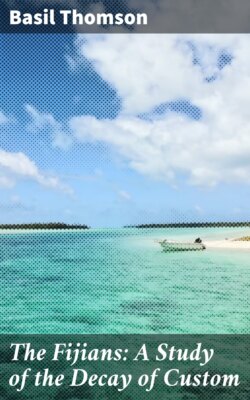Читать книгу The Fijians: A Study of the Decay of Custom - Thomson Basil - Страница 13
На сайте Литреса книга снята с продажи.
THE AGE OF HISTORY
ОглавлениеTable of Contents
Of the centuries that lie between the age of myth and the age of history there are but the feeblest echoes. From the ethnology of the people of to-day we may infer that the stream of immigration swept down the northern coast of Vitilevu, and, radiating from Rakiraki, crossed the mountain range, and wandered down the two rivers, Rewa and Singatoka, until it reached the southern coast and peopled Serua and Namosi. Another stream must have crossed the strait to Mbua on Vanualevu, and spread eastward. Melanesian blood can be traced even in the Lau sub-group, but before any permanent settlement was made there Polynesian castaways, driven westward by the prevailing wind, must have begun to arrive. At the dawn of history, about 1750, Vitilevu was almost purely Melanesian, but the Lau and Lomaiviti islands, Taveuni, Vanualevu, and Kandavu were peopled by half-breeds between Melanesian and Polynesian, the Polynesian strain waxing stronger with every mile from west to east.
The peopling of the waste lands was accelerated by war. There is scarcely a tribe that does not claim to have migrated from another place, sometimes from parts relatively remote from its present locality, and if it were worth the labour, the history of the migrations of each of them might even now be compiled, partly from its own traditions, partly from the tie of tauvu (common Ancestor-gods) with other tribes distantly related to it. But, as it would be merely the history of a few fugitives from the sack of a village, driven out to find asylum in a waste valley, and founding in it a joint family which lived to grow into a tribe, such an inquiry would be barren and profitless.
The traditions of Tongan immigration are too numerous to be set down here. From 1790, if not earlier, an expedition to Fiji was an annual occurrence. The most important was the arrival of the Tui Tonga's canoe in Taveuni, from which sprang the chief family of the Tui Thakau, and the stranding of the two little old men who instituted the Nanga Cult, which recalls the rites of the Polynesian Malae. The chiefs of the Nandronga and Viwa (Yasawa) also trace their descent from Tongan castaways, and are very proud of the connection.
The fact that traditionary history is so meagre is in itself an indication that there were no powerful confederations before the nineteenth century. The related tribes of Verata and Rewa in the south and Thakaundrove in the north-east seem to have been the only powers that wielded influence beyond their borders, but their intercourse with other tribes must have been very restricted. In islands where male castaways, having "salt water in their eyes," were killed and eaten, there was little spirit for discovery and adventure.
The imprint of the Tongan immigration is to be seen, not only in the blood of the tribes with whom the immigrants mingled, but in their mythology, for whereas the religion of the inland tribes is pure ancestor-worship, that of the coast tribes is overlaid with a mythology that is evidently derived from Polynesian sources.
